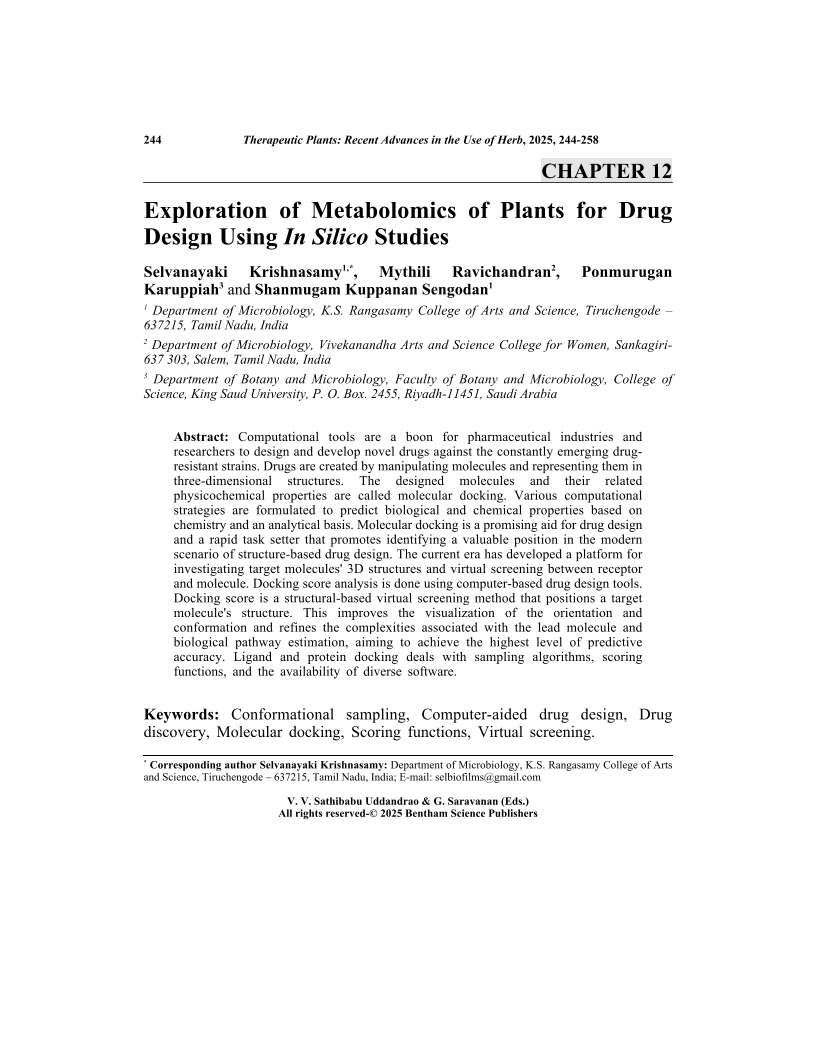Exploration of Metabolomics of Plants for Drug Design Using In Silico Studies

- Authors: Selvanayaki Krishnasamy1, Mythili Ravichandran2, Ponmurugan Karuppiah3, Shanmugam Kuppanan Sengodan4
-
View Affiliations Hide Affiliations1 Department of Microbiology, K.S. Rangasamy College of Arts and Science, Tiruchengode 637215, Tamil Nadu, India 2 Department of Microbiology, Vivekanandha Arts and Science College for Women, Sankagiri637 303, Salem, Tamil Nadu, India 3 Department of Botany and Microbiology, Faculty of Botany and Microbiology, College of Science, King Saud University, P. O. Box. 2455, Riyadh 11451, Saudi Arabia 4 Department of Microbiology, K.S. Rangasamy College of Arts and Science, Tiruchengode 637215, Tamil Nadu, India
- Source: Therapeutic Plants: Recent Advances in the Use of Herbs as Alternative Medications , pp 244-258
- Publication Date: May 2025
- Language: English
Exploration of Metabolomics of Plants for Drug Design Using In Silico Studies, Page 1 of 1
< Previous page | Next page > /docserver/preview/fulltext/9789815322910/chapter-12-1.gif
Computational tools are a boon for pharmaceutical industries and researchers to design and develop novel drugs against the constantly emerging drugresistant strains. Drugs are created by manipulating molecules and representing them in three-dimensional structures. The designed molecules and their related physicochemical properties are called molecular docking. Various computational strategies are formulated to predict biological and chemical properties based on chemistry and an analytical basis. Molecular docking is a promising aid for drug design and a rapid task setter that promotes identifying a valuable position in the modern scenario of structure-based drug design. The current era has developed a platform for investigating target molecules' 3D structures and virtual screening between receptor and molecule. Docking score analysis is done using computer-based drug design tools. Docking score is a structural-based virtual screening method that positions a target molecule's structure. This improves the visualization of the orientation and conformation and refines the complexities associated with the lead molecule and biological pathway estimation, aiming to achieve the highest level of predictive accuracy. Ligand and protein docking deals with sampling algorithms, scoring functions, and the availability of diverse software.
-
From This Site
/content/books/9789815322910.chapter-12dcterms_subject,pub_keyword-contentType:Journal -contentType:Figure -contentType:Table -contentType:SupplementaryData105

